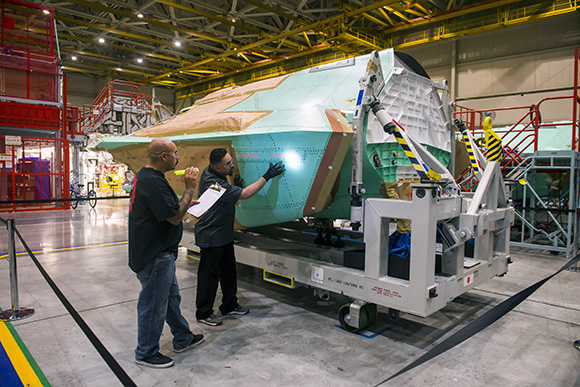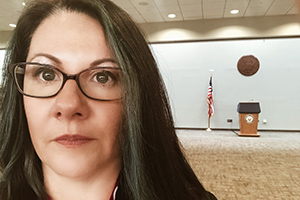
Technicians at the Northrop Grumman Palmdale facility (Photo: Northrop Grumman)
For much of the past two decades, a remarkable partnership between Antelope Valley College and aerospace manufacturer Northrop Grumman has been a blueprint for what a productive community college-employer relationship looks like.
And the result has been the placement of thousands of students into jobs at the manufacturer’s facility in Palmdale. This program also was one of the winning entries in the first annual Partnership for Industry and Education (PIE) awards run by the California Economic Summit in 2017.
How has it worked this well for this long?
One constant during that time has been Dr. Maria Clinton, professor of aeronautical sciences and technologies at AVC.
“The key to the success of our relationship has been direct communication between the company and the college,” said Clinton. “We meet once a month and sometimes more frequently, if it’s needed.”
“The relationship is solid. If we find that’s something’s not working, we fix it.”
 And it’s not just the company that Dr. Clinton keeps in the loop. She meets with all faculty members at least two times every semester. There are three full-time CTE faculty members and 20 adjunct instructors, many of whom work for Northrop Grumman.
And it’s not just the company that Dr. Clinton keeps in the loop. She meets with all faculty members at least two times every semester. There are three full-time CTE faculty members and 20 adjunct instructors, many of whom work for Northrop Grumman.
Talk with company leaders and they tell you that Dr. Clinton is a big reason for the program’s success.
“Maria knows how to get things done in a timely and efficient manner. The nature of our work is that change is a constant and her ability to adjust and adapt keeps the curriculum relevant and the students ready for employment when they finish the program,” said Mike Watson, manager for Northrop Grumman’s Employee Development Global Operations.
For Clinton’s peers at other community colleges, how to nimbly respond to rapid change is also a constant.
“The course objectives are encompassing and when the company needs to make a change, we make sure the Course Outline of Record is changed,” said Dr. Clinton.
Sometimes what the company must provide resources—like tooling—in order to make sure the classes have the necessary materials. It’s the active communication and resulting action that makes this relationship work.
This is done through participation by Northrop Grumman on AVC advisory boards and foundation boards, as well as AVC’s participation in working level meetings at Northrop Grumman.
“We never forget that we are here to help the students get a job,” Dr. Clinton said. “It’s what drives us.”
And it’s working.
When a student completes the certificate of aircraft fabrication & assembly technician, he or she will have acquired knowledge of aerodynamics, use of basic hand and power tools, safe work aircraft fabrication & assembly technician practices, industry standards, blueprint interpretation, aircraft fabrication techniques and use of composite materials. They also learn ethical responsibilities of aircraft technicians and aircraft production organization.
Historically, the college has had a 94 percent placement rate of its students—and last November 155 students were hired by the company. And those students—like the population at all of California’s 115 community colleges—can range in age from young people right out of high school to mid-career people who are looking to upgrade their work skills or are looking for a new challenge.
While most are placed at Northrop Grumman, the students are also qualified for jobs with Lockheed Martin Corporation, The Boeing Company, Scaled Composites, LLC, General Atomics, as well as general aviation firms, aircraft manufacturers and commercial airlines.
While some at other community colleges may wonder how to duplicate the success of the AVC/Northrop Grumman relationship, Dr. Clinton thinks the prescription is simple.
“We have a great administration at the college and a willing and motivated partner in Northrop Grumman,” she noted. “Finding a champion at the employer and establishing trust is paramount. After that it’s paying attention to details.”
Good advice.

